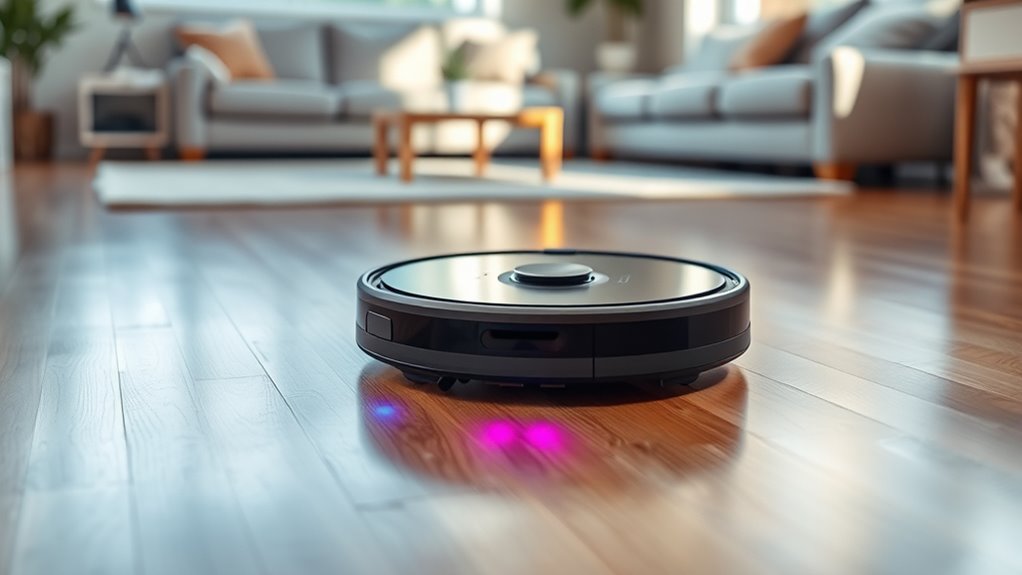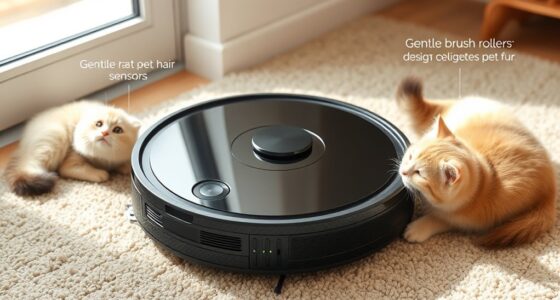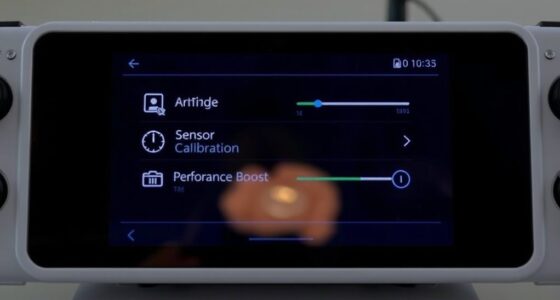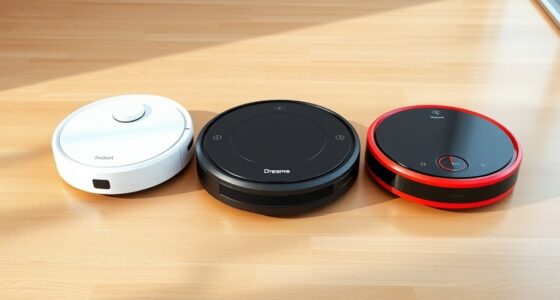Use Turbo mode when tackling stubborn dirt, pet hair, or heavily soiled areas for deep cleaning. Switch to Quiet mode for light cleaning on hard floors or during quiet hours to minimize noise. Eco mode is best for regular maintenance on clean surfaces or light dust, conserving battery life. Understanding when to apply each mode helps your robot vacuum work efficiently. Keep exploring to discover how sensor tech and battery management enhance these modes even further.
Key Takeaways
- Use Turbo mode for stubborn dirt, pet hair, or heavily soiled areas requiring maximum cleaning power.
- Activate Quiet mode during noise-sensitive times or for light cleaning on hard floors.
- Switch to Eco mode for light dust, minimal debris, or when conserving battery life on less dirty surfaces.
- Automatically adjust modes based on sensor detection of dirt level and surface type for optimal efficiency.
- Reserve higher power modes for carpets and deep cleaning, switching to energy-saving modes on hard, clean surfaces.

Have you ever wondered how robot vacuums decide which cleaning mode to use? It all comes down to a combination of smart technology and power management. Modern vacuums are designed to optimize their performance by choosing the right mode based on your cleaning needs and their own capabilities. One key factor they consider is battery life management. When your vacuum senses that the battery is running low, it might switch to a more energy-efficient mode to conserve power and guarantee it can finish the job or return to its dock without dying mid-clean. Conversely, if the dirt is particularly stubborn or the area is heavily soiled, it might ramp up to a more powerful mode, like Turbo, to tackle tougher debris. Advances in sensor technology also play a vital role here. Enhanced sensors allow the vacuum to detect the type and amount of dirt on the floor, enabling it to adjust cleaning modes dynamically. For instance, if sensors pick up a lot of dust or pet hair, the vacuum might automatically switch to Turbo mode for a more thorough clean. Additionally, integrating performance tuning principles can improve the vacuum’s efficiency and responsiveness. Sensor technology advances have made these decisions more intuitive and responsive. They enable the vacuum to detect obstacles, determine the surface type, and assess the level of dirt, all in real time. This means you don’t have to manually change modes; the vacuum intelligently adapts to the environment. For example, on hard floors with light dust, it might use Eco mode to save energy, while on carpets with embedded pet hair, it switches to Turbo for deep cleaning. These sensors also help avoid obstacles, preventing damage and guaranteeing efficient coverage.
Battery life management is increasingly sophisticated, allowing robot vacuums to balance power and performance. When a high-performance mode is unnecessary, the vacuum conserves energy for longer cleaning sessions or to return to its dock sooner. Some models even monitor remaining battery life and plan their cleaning routes accordingly, ensuring they don’t get stranded mid-clean. This synergy between sensor technology and battery management results in a seamless cleaning experience. You get a device that intelligently adapts to your home’s needs, cleaning effectively while conserving power.
Frequently Asked Questions
How Do I Switch Between Different Cleaning Modes?
To switch between different cleaning modes, start by accessing your robot vacuum’s control panel or app. You can usually select manual mode for spot cleaning or scheduled cleaning for regular maintenance. Simply tap or press the mode you prefer, and the vacuum will adjust accordingly. Make sure your device is powered on and connected if using an app, so you can easily choose between modes like turbo, quiet, or eco.
Can I Customize Modes for Specific Rooms?
You can often customize modes for specific rooms by utilizing room-specific settings or custom mode creation features. Check your robot vacuum’s app to see if it allows you to assign different cleaning modes to certain areas. By creating custom modes, you guarantee your vacuum cleans each room according to its needs, whether that’s a quick pass or a thorough clean. This way, you get tailored cleaning for every part of your home.
Do Modes Affect Battery Life Significantly?
Yes, modes do affect battery life considerably. When you switch to Turbo mode, the robot works harder, causing faster battery drain due to increased mode efficiency. Quiet and Eco modes use less power, extending your vacuum’s runtime. If you want to conserve battery, stick with Eco mode for light cleaning or Quiet mode for quieter operation. Understanding these differences helps you optimize cleaning time based on your needs.
Are There Safety Concerns With High-Speed Modes?
Think of high-speed modes like a racecar—exciting but needing caution. While they don’t inherently pose safety risks, it’s smart to follow safety precautions, such as keeping cords away and supervising during operation. Some models include emergency shutdowns, giving you peace of mind. Using these modes responsibly minimizes hazards, ensuring your robot vacuum cleans efficiently without compromising safety. Always read your device’s manual for specific safety features.
How Often Should I Change Filters When Using Different Modes?
You should change your filters regularly to maintain ideal performance, regardless of the mode you use. Check your filter’s lifespan and follow maintenance tips from the manufacturer—usually, filters need replacing every 2-3 months with frequent use. Using higher modes like Turbo may clog filters faster, so you might need to change them more often. Keep an eye on filter condition to guarantee your vacuum runs efficiently and prolongs its lifespan.
Conclusion
Now that you know when to switch between turbo, quiet, and eco modes, your robot vacuum becomes your trusty sidekick in conquering dirt. Think of it as a chameleon, blending seamlessly into your cleaning routine like a master artist choosing the perfect brush. With each mode, you’re tuning your cleaning symphony to suit the moment—whether it’s a thorough immersion into stubborn grime or a gentle whisper of cleanliness. Your home’s sparkling future is just a switch away.









